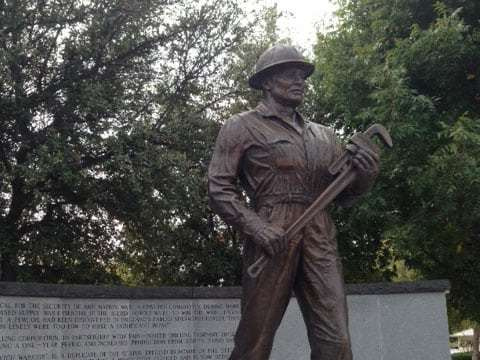Seventy-five years ago this month, a Band of Roughnecks went abroad on a top secret mission into Robin Hood’s stomping grounds to punch oil wells to help fuel England’s war machines.
It’s a story that should make any oilman or woman proud.
The year was 1943 and England was mired in World War II. U-boats attacked supply vessels, choking off badly needed supplies to the island nation. But oil was the commodity they needed the most as they warred with Germany.
A book “The Secret of Sherwood Forest: Oil Production in England During World War II” written by Guy Woodward and Grace Steele Woodward was published in 1973, and tells the obscure story of the American oil men who went to England to bore wells in a top secret mission in March 1943.
England had but one oil field, in Sherwood Forest of all places. Its meager output of 300 barrels a day was literally a drop in the bucket of their requirement of 150,000 barrels a day to fuel their war machines.
Then a top secret plan was devised: to send some Americans and their expertise to assist in developing the field. Oklahoma based Noble Drilling Company, along with Fain-Porter signed a one year contract to drill 100 wells for England, merely for costs and expenses.
42 drillers and roughnecks from Texas and Oklahoma, most in their teens and early twenties volunteered for the mission to go abroad. The hands embarked for England in March 1943 aboard the HMS Queen Elizabeth. Four National 50 drilling rigs were loaded onto ships but only three of them made landfall; the Nazi U-boats sank one of the rigs en route to the UK.
The Brits’ jaws dropped as the Yanks began punching the wells in a week, compared to five to eight weeks for their British counterparts. They worked 12 hour tours, 7 days a week and within a year, the Americans had drilled 106 wells and England oil production shot up from 300 barrels a day to over 300,000
The contract fulfilled, the American oil men departed England in late March 1944. But only 41 hands were on board the return voyage. Herman Douthit, a Texan derrick-hand was killed during the operation. He was laid to rest with full military honors, and remains the only civilian to be buried at The American Military Cemetery in Cambridge.
“The Oil Patch Warrior,” a seven foot bronze statue of a roughneck holding a four foot pipe wrench stands near Nottingham England to honor the American oil men’s assistance and sacrifice in the war. A replica was placed in Ardmore Oklahoma in 2001
It is by no means a stretch to state that without the American mission, we might all be speaking German today.
Special thanks to the American Oil and Gas Historical Society.
"There are no noble wars, just noble warriors
////////////////Too bad the image wouldn’t load…the bronze statue is impressive…an homage to the US roughnecks who helped win the war for the US/Britain. /////////////////, Reeves county, Tx
